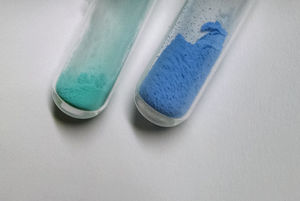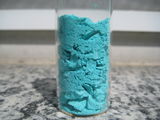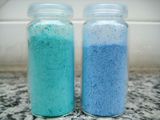Difference between revisions of "Copper citrate"
| (6 intermediate revisions by 2 users not shown) | |||
| Line 8: | Line 8: | ||
<!-- Images --> | <!-- Images --> | ||
| ImageFile = File:Copper_citrate_dehydration.jpg | | ImageFile = File:Copper_citrate_dehydration.jpg | ||
| − | | ImageSize = | + | | ImageSize = 300 |
| ImageAlt = | | ImageAlt = | ||
| ImageName = | | ImageName = | ||
| + | | ImageCaption = Anhydrous (left) and hydrated (right) copper citrate. | ||
| ImageFile1 = | | ImageFile1 = | ||
| ImageSize1 = | | ImageSize1 = | ||
| Line 47: | Line 48: | ||
| Section2 = {{Chembox Properties | | Section2 = {{Chembox Properties | ||
| AtmosphericOHRateConstant = | | AtmosphericOHRateConstant = | ||
| − | | Appearance = Blue solid (anhydrous)<br> | + | | Appearance = Blue solid (anhydrous)<br>Turquoise (hemipentahydrate) |
| BoilingPt = | | BoilingPt = | ||
| BoilingPtC = | | BoilingPtC = | ||
| Line 60: | Line 61: | ||
| MeltingPtC = | | MeltingPtC = | ||
| MeltingPt_ref = | | MeltingPt_ref = | ||
| − | | MeltingPt_notes = | + | | MeltingPt_notes = Decomposes |
| + | | Odor = Odorless | ||
| pKa = | | pKa = | ||
| pKb = | | pKb = | ||
| Line 66: | Line 68: | ||
| SolubleOther = Insoluble in halocarbons, hydrocarbons | | SolubleOther = Insoluble in halocarbons, hydrocarbons | ||
| Solvent = | | Solvent = | ||
| − | | VaporPressure = | + | | VaporPressure = ~0 mmHg |
}} | }} | ||
| Section3 = {{Chembox Structure | | Section3 = {{Chembox Structure | ||
| Line 107: | Line 109: | ||
}} | }} | ||
}} | }} | ||
| − | '''Copper(II) citrate''', also known as '''cuprocitrol''', is an ionic compound of [[copper]] and [[citric acid]] with the formula '''Cu<sub>3</sub>(C<sub>6</sub>H<sub>5</sub>O<sub>7</sub>)<sub>2</sub>''' or '''Cu<sub>3</sub>C<sub>12</sub>H<sub>10</sub>O<sub>14</sub>''', with a molecular weight of 568.85 g/mol. Some resources incorrectly list its formula as Cu<sub>2</sub>C<sub>6</sub>H<sub>4</sub>O<sub>7</sub> and a molecular weight of 360.2 g/mol, but this formulation would require the citric acid molecule to lose more protons than it has carboxylic groups | + | '''Copper(II) citrate''', also known as '''cuprocitrol''', is an ionic compound of [[copper]] and [[citric acid]] with the formula '''Cu<sub>3</sub>(C<sub>6</sub>H<sub>5</sub>O<sub>7</sub>)<sub>2</sub>''' or '''Cu<sub>3</sub>C<sub>12</sub>H<sub>10</sub>O<sub>14</sub>''', with a molecular weight of 568.85 g/mol. It exists as a seafoam green hemipentahydrate and a sky-blue anhydrous solid. |
| + | |||
| + | Some resources incorrectly list its formula as Cu<sub>2</sub>C<sub>6</sub>H<sub>4</sub>O<sub>7</sub> and a molecular weight of 360.2 g/mol, but this formulation would require the citric acid molecule to lose more protons than it has carboxylic groups. | ||
==Properties== | ==Properties== | ||
===Chemical=== | ===Chemical=== | ||
| − | |||
Copper citrate is soluble in alkaline citrate solutions. | Copper citrate is soluble in alkaline citrate solutions. | ||
The hydrated salt will lose its water of crystallization at 100 °C, turning from green to blue. | The hydrated salt will lose its water of crystallization at 100 °C, turning from green to blue. | ||
| − | When heated more strongly, the salt decomposes, leaving behind solid copper particles. When heated under vacuum, the residue is claimed to be pyrophoric <ref>Gorrie, T., Kopf, P., & Toby, S. (1967) | + | When heated more strongly, the salt decomposes, leaving behind solid copper particles. When heated under vacuum, the resulting residue is claimed to be pyrophoric.<ref>Gorrie, T., Kopf, P., & Toby, S. (1967) Kinetics of the reaction of some pyrophoric metals with oxygen. The Journal of Physical Chemistry, 1478(4), 3842–3845. Retrieved from http://pubs.acs.org/doi/pdf/10.1021/j100871a019</ref> |
===Physical=== | ===Physical=== | ||
| + | Copper citrate is a blueish solid, soluble in water. | ||
| + | ==Availability== | ||
| + | Copper citrate is found in some sulfur smell removing products used in winemaking, like [https://www.erbsloeh.com/product_datasheets/en/kupzit-technical_data_sheet-english-erbsloeh-20171109-003.pdf Kupzit].<ref>https://www.wineland.co.za/vineyard-and-cellar-update-the-use-of-copper-citrate-to-remove-sulphur-compounds/</ref> | ||
==Preparation== | ==Preparation== | ||
| − | Copper citrate can be made by reacting copper oxide or hydroxide with citric acid. | + | Copper citrate can be made by reacting [[copper(II) oxide]] or hydroxide with [[citric acid]]. |
| + | |||
| + | : 3 CuO + 2 C<sub>6</sub>H<sub>8</sub>O<sub>7</sub> → Cu<sub>3</sub>C<sub>12</sub>H<sub>10</sub>O<sub>14</sub> + 3 H<sub>2</sub>O | ||
Copper citrate has a low solubility in water, and can be prepared by precipitation from aqueous solution containing copper and citrate ions. A procedure is available from the Royal Society for Chemistry<ref> | Copper citrate has a low solubility in water, and can be prepared by precipitation from aqueous solution containing copper and citrate ions. A procedure is available from the Royal Society for Chemistry<ref> | ||
| − | Preparation of copper(II) citrate. RSC Student worksheet, http://www.rsc.org/learn-chemistry/resource/download/res00000903/cmp00001141/pdf</ref> describing its preparation from citric acid or trisodium citrate and copper acetate or sulfate. However, when followed, the reaction proceeds only very slowly, and deposits the product as a crust. Heating the mixture will accelerate the reaction and give a finely-divided product. | + | Preparation of copper(II) citrate. RSC Student worksheet, http://www.rsc.org/learn-chemistry/resource/download/res00000903/cmp00001141/pdf</ref> describing its preparation from citric acid or trisodium citrate and copper acetate or sulfate. However, when followed, the reaction proceeds only very slowly, and deposits the product as a crust. Heating the mixture will accelerate the reaction and give a finely-divided product.<ref>https://www.youtube.com/watch?v=PTp0yf_Wgk8</ref> |
Magnesium citrate, available in solution as a laxative, can also be used in place of trisodium citrate. | Magnesium citrate, available in solution as a laxative, can also be used in place of trisodium citrate. | ||
==Projects== | ==Projects== | ||
| − | + | *Make pyrophoric copper | |
| + | *Compound collecting | ||
==Handling== | ==Handling== | ||
===Safety=== | ===Safety=== | ||
| − | Copper citrate | + | Copper citrate has low toxicity, though copper ions are harmful if consumed in large quantities. |
===Storage=== | ===Storage=== | ||
| − | + | Copper citrate should be kept in closed bottles, or air tight sealed ones if you want the anhydrous form. | |
===Disposal=== | ===Disposal=== | ||
| − | Copper citrate should be disposed of just any other copper compound. | + | Copper citrate should be disposed of just any other copper compound. Which is reduction to metallic copper followed by recycling. Although if the amount you hae is very small, you may flush it down the drain with lots of water. |
| + | |||
| + | ==Gallery== | ||
| + | <gallery widths="200" position="center" columns="4" orientation="none"> | ||
| + | Copper(II)_citrate_pentahydrate.jpg|Hydrated copper(II) citrate | ||
| + | Copper(II)_citrate_pentahydrate_anhydrous.jpg|Hydrated (left) and anhydrous (right) copper(II) citrate | ||
| + | </gallery> | ||
==References== | ==References== | ||
| Line 154: | Line 169: | ||
[[Category:Citrates]] | [[Category:Citrates]] | ||
[[Category:Easily prepared chemicals]] | [[Category:Easily prepared chemicals]] | ||
| + | [[Category:Readily available chemicals]] | ||
Latest revision as of 21:49, 20 August 2021
 Anhydrous (left) and hydrated (right) copper citrate.
| |
| Names | |
|---|---|
| IUPAC name
Copper 2-hydroxypropane-1,2,3-tricarboxylate
| |
| Other names
Cuprocitrol
| |
| Properties | |
| Cu3C12H10O14 | |
| Molar mass | 568.85 g/mol |
| Appearance | Blue solid (anhydrous) Turquoise (hemipentahydrate) |
| Odor | Odorless |
| Melting point | Decomposes |
| Boiling point | Decomposes |
| Slightly soluble | |
| Solubility | Insoluble in halocarbons, hydrocarbons |
| Vapor pressure | ~0 mmHg |
| Hazards | |
| Safety data sheet | None |
| Related compounds | |
| Related compounds
|
Copper(II) acetate |
| Except where otherwise noted, data are given for materials in their standard state (at 25 °C [77 °F], 100 kPa). | |
| Infobox references | |
Copper(II) citrate, also known as cuprocitrol, is an ionic compound of copper and citric acid with the formula Cu3(C6H5O7)2 or Cu3C12H10O14, with a molecular weight of 568.85 g/mol. It exists as a seafoam green hemipentahydrate and a sky-blue anhydrous solid.
Some resources incorrectly list its formula as Cu2C6H4O7 and a molecular weight of 360.2 g/mol, but this formulation would require the citric acid molecule to lose more protons than it has carboxylic groups.
Contents
Properties
Chemical
Copper citrate is soluble in alkaline citrate solutions.
The hydrated salt will lose its water of crystallization at 100 °C, turning from green to blue.
When heated more strongly, the salt decomposes, leaving behind solid copper particles. When heated under vacuum, the resulting residue is claimed to be pyrophoric.[1]
Physical
Copper citrate is a blueish solid, soluble in water.
Availability
Copper citrate is found in some sulfur smell removing products used in winemaking, like Kupzit.[2]
Preparation
Copper citrate can be made by reacting copper(II) oxide or hydroxide with citric acid.
- 3 CuO + 2 C6H8O7 → Cu3C12H10O14 + 3 H2O
Copper citrate has a low solubility in water, and can be prepared by precipitation from aqueous solution containing copper and citrate ions. A procedure is available from the Royal Society for Chemistry[3] describing its preparation from citric acid or trisodium citrate and copper acetate or sulfate. However, when followed, the reaction proceeds only very slowly, and deposits the product as a crust. Heating the mixture will accelerate the reaction and give a finely-divided product.[4]
Magnesium citrate, available in solution as a laxative, can also be used in place of trisodium citrate.
Projects
- Make pyrophoric copper
- Compound collecting
Handling
Safety
Copper citrate has low toxicity, though copper ions are harmful if consumed in large quantities.
Storage
Copper citrate should be kept in closed bottles, or air tight sealed ones if you want the anhydrous form.
Disposal
Copper citrate should be disposed of just any other copper compound. Which is reduction to metallic copper followed by recycling. Although if the amount you hae is very small, you may flush it down the drain with lots of water.
Gallery
References
- ↑ Gorrie, T., Kopf, P., & Toby, S. (1967) Kinetics of the reaction of some pyrophoric metals with oxygen. The Journal of Physical Chemistry, 1478(4), 3842–3845. Retrieved from http://pubs.acs.org/doi/pdf/10.1021/j100871a019
- ↑ https://www.wineland.co.za/vineyard-and-cellar-update-the-use-of-copper-citrate-to-remove-sulphur-compounds/
- ↑ Preparation of copper(II) citrate. RSC Student worksheet, http://www.rsc.org/learn-chemistry/resource/download/res00000903/cmp00001141/pdf
- ↑ https://www.youtube.com/watch?v=PTp0yf_Wgk8

